Middle back pain is a common but often overlooked source of discomfort that can significantly impact everyday life. While the lower back and neck typically receive more attention in fitness routines and physical therapy plans, the thoracic spine—located in the middle of the back—is a critical region for maintaining posture, supporting spinal alignment, and facilitating upper body mobility. Unfortunately, when middle back pain strikes, it can be difficult to pinpoint the cause, and equally challenging to treat without guidance. This article explores fifteen middle back pain relief exercises and stretches, each supported by expert recommendations, to help improve flexibility, address tightness, and ease discomfort. These movements are particularly effective for people experiencing tight middle back muscles, muscular spasms, or general mid back stiffness. They are also suitable for individuals seeking to improve their overall spinal health through yoga, stretching, and fitness-based approaches.
You may also like : Best Stretches for Sore Legs and Tight Thigh Muscles: How to Relieve Upper Leg Pain Safely and Naturally
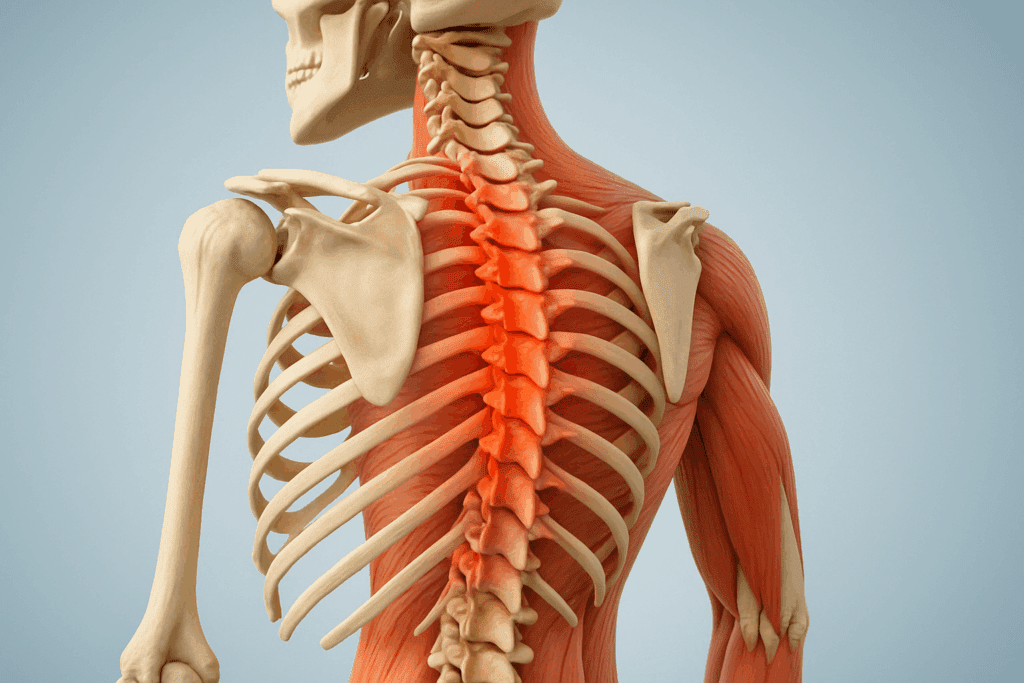
Understanding the Nature and Causes of Mid Back Pain
Middle back pain typically originates in the thoracic spine, which consists of twelve vertebrae (T1–T12) connected to the rib cage. This area plays a pivotal role in stabilizing the upper body and supporting breathing mechanics. While thoracic spine injuries are less common than those in the cervical or lumbar regions, the middle back can become a site of chronic pain due to poor posture, muscular imbalances, sedentary behavior, or improper lifting techniques. In many cases, the discomfort stems not from structural issues but from functional limitations like tight middle back muscles, strained ligaments, or localized inflammation. Understanding these root causes is essential for choosing the most effective stretches for back muscle spasms and implementing long-term preventive strategies.
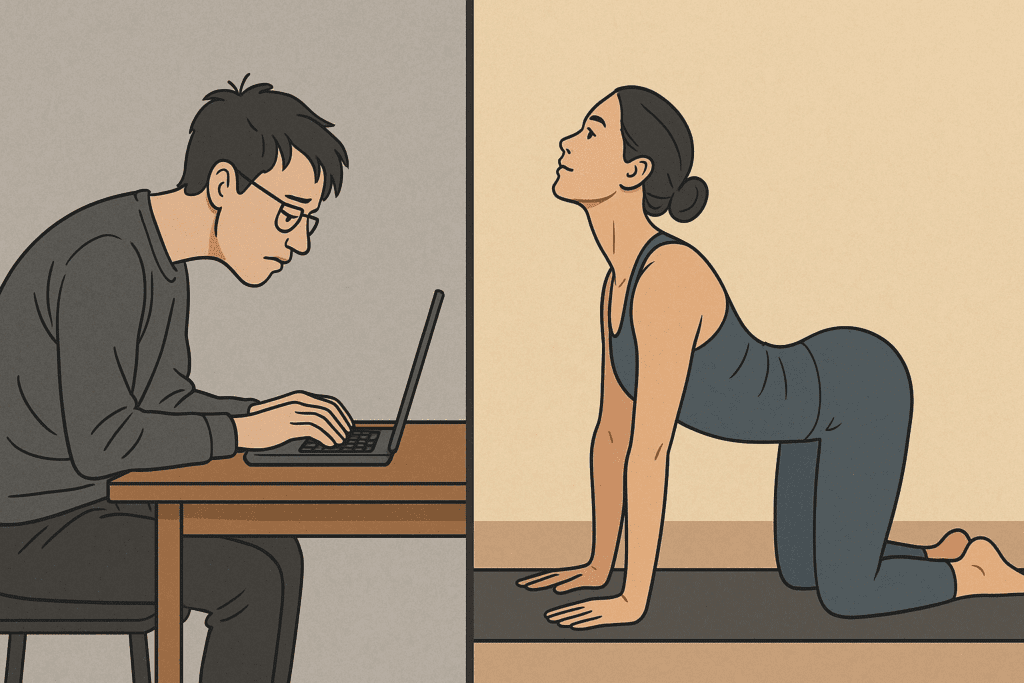
The Importance of Movement and Flexibility in Middle Back Health
Maintaining thoracic spine mobility is crucial for preventing mid back pain and promoting spinal longevity. Modern lifestyles often promote forward-slouched posture, especially among people who work at desks or spend hours on digital devices. This leads to shortened chest muscles, overstretched rhomboids, and tight muscles in the mid back. These patterns gradually reduce range of motion and place strain on the spine and surrounding tissues. By incorporating targeted middle back pain stretching exercises, individuals can counteract these effects, release tension, and restore mobility. Even simple practices like yoga for middle back pain or gentle back stretches for the mid back can dramatically reduce pain, improve posture, and enhance day-to-day functioning.
Ergonomics and Workplace Modifications for Mid Back Relief
Sedentary work environments are a leading contributor to thoracic discomfort. Prolonged sitting with poor alignment leads to the development of tight muscles in the mid back, which eventually causes or worsens pain. Incorporating ergonomic assessments into daily life is an underutilized but critical strategy for middle back pain prevention and relief. Adjusting monitor height, using lumbar support cushions, and standing at regular intervals can all mitigate pressure on the thoracic spine. Ergonomic sit-stand desks are particularly effective for promoting spinal mobility throughout the day. Pairing these changes with short sessions of stretches for back spasms or gentle mid back yoga poses ensures dynamic support for spinal health during long work hours.
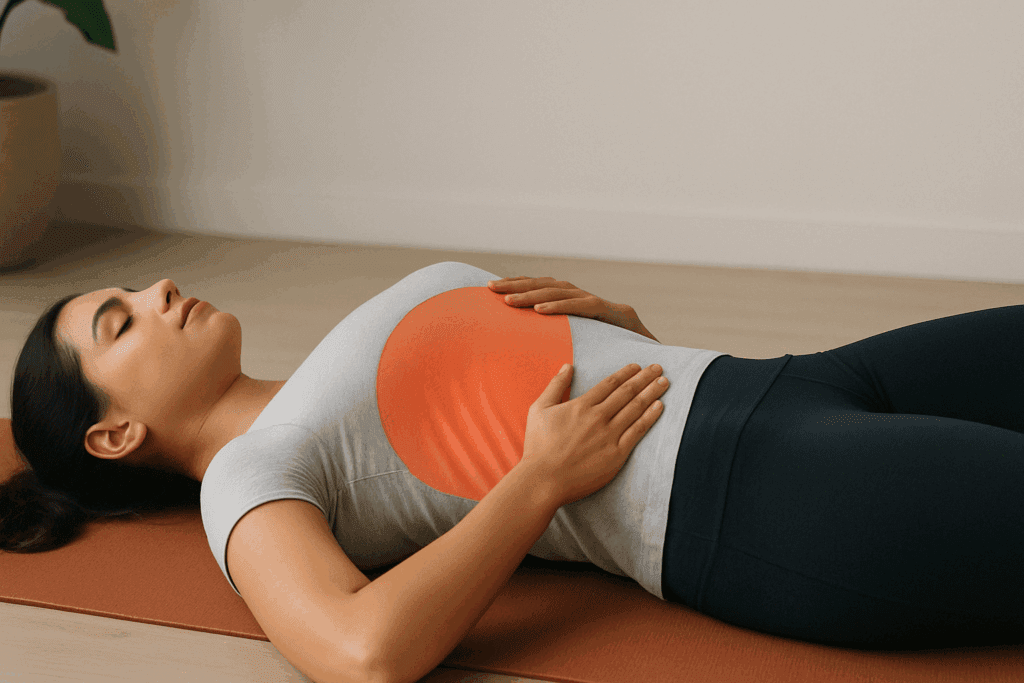
Breathwork and Diaphragmatic Engagement in Thoracic Mobility
The thoracic spine is intricately linked with the rib cage and respiratory system. As such, breathing mechanics have a profound impact on middle back pain. Shallow chest breathing, common in individuals under chronic stress or poor posture, restricts rib expansion and places additional strain on thoracic vertebrae. Deep diaphragmatic breathing, on the other hand, enhances rib cage mobility and naturally decompresses the spine. Practicing breath-based techniques during yoga for middle back pain or integrating breath-focused stretches can significantly improve outcomes. Even simple practices like three-part breathing or alternate nostril breathing, when combined with physical movement, activate the parasympathetic nervous system and support muscular relaxation.
The Impact of Sleep Position and Mattress Choice on Mid Back Pain
Although often overlooked, sleep habits play a critical role in spinal alignment and recovery. Sleeping on a mattress that does not support the spine evenly can contribute to middle spine pain, especially if the thoracic region sags or remains unsupported. Side sleepers, in particular, may experience compression in the ribs and shoulders, leading to tightness and discomfort in the middle back. Experts recommend medium-firm mattresses and supportive pillows that maintain spinal neutrality across all sleep positions. Additionally, incorporating a nighttime routine of middle back pain stretching exercises before bed can help loosen tight muscles and improve sleep quality, reducing nighttime pain episodes.

How Exercise Can Help Relieve Mid Back Pain
Exercise not only strengthens the muscles that support the spine, but also improves circulation, reduces inflammation, and promotes alignment. When chosen carefully, middle back pain exercises can create a therapeutic balance between activation and relaxation. For example, engaging the spinal erectors with extension-based movements can stabilize the spine, while stretches for back spasms target tightness and help release muscle knots. Furthermore, incorporating mid back yoga poses provides a holistic approach by blending breathwork, stretching, and strengthening into a single practice. These exercises are suitable not just for managing pain, but also for preventing future episodes of discomfort, especially when practiced consistently under proper form.
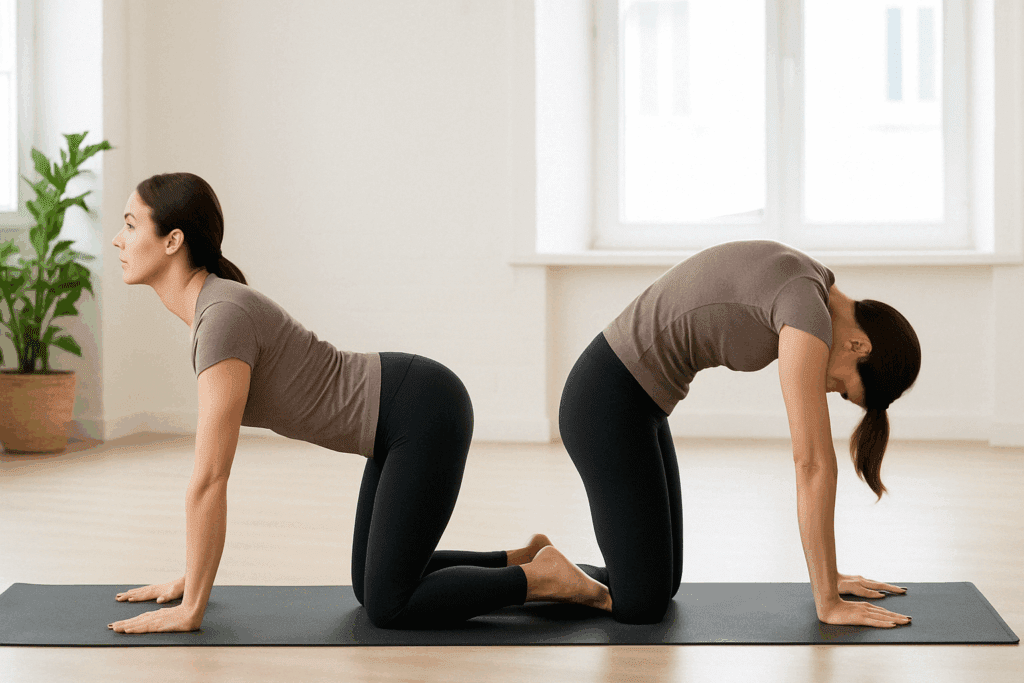
Cat-Cow Stretch for Mid Back Mobility
The Cat-Cow stretch is a foundational yoga pose frequently used in physical therapy exercises for mid back pain due to its ability to improve spinal articulation. Starting on hands and knees in a tabletop position, practitioners alternate between arching the back (cow) and rounding the spine (cat). This dynamic flow mobilizes the thoracic vertebrae, increases awareness of spinal movement, and gently activates the paraspinal muscles. Regular practice of this stretch enhances flexibility and is considered one of the most effective middle back pain relief exercises for individuals dealing with stiffness or poor posture.
Thread the Needle to Release Tension in the Thoracic Spine
Thread the Needle is another yoga pose for middle back pain that provides a deep twist while promoting shoulder and upper back mobility. From a tabletop position, one arm is threaded underneath the body, allowing the torso to rotate gently. This rotation stretches the rhomboids, traps, and erector spinae muscles—key areas where tight muscles in the mid back tend to accumulate tension. As a middle back pain yoga stretch, this pose helps relieve mid back pain caused by chronic sitting or unbalanced movement patterns, particularly when held for extended periods with deep, mindful breathing.
Child’s Pose for Gentle Stretching and Relaxation
Child’s Pose is a well-known resting posture in yoga that can be adapted to focus on the middle spine. By extending the arms forward and lowering the torso to the ground, practitioners stretch the length of the spine while encouraging the release of tight middle back muscles. This position is gentle enough for those experiencing acute discomfort and is considered one of the best stretches for back muscle spasms when relaxation is a primary goal. When modified with props like a cushion or bolster, Child’s Pose becomes a restorative tool for calming the nervous system and fostering middle back pain relief through passive stretching.
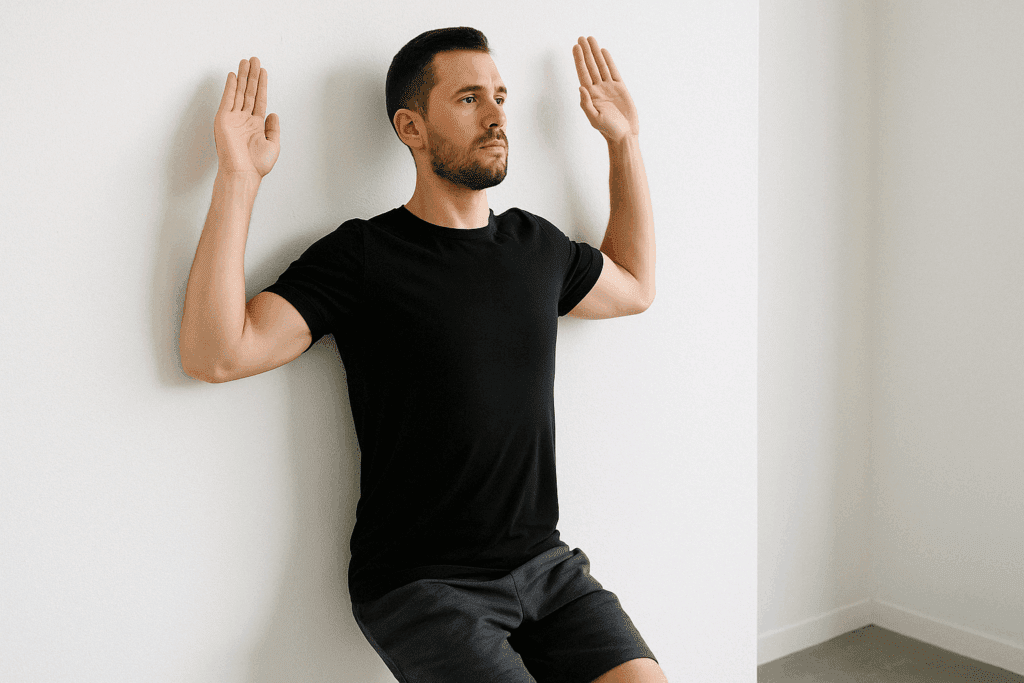
Wall Angels for Postural Correction and Strengthening
Wall Angels are a postural re-education exercise often included in middle spine pain exercises. By standing with the back against a wall and moving the arms in a controlled up-and-down motion, individuals engage the scapular stabilizers and thoracic extensors. This helps correct postural imbalances that contribute to tight muscles in the mid back. Wall Angels are particularly effective for reversing rounded shoulders and forward head posture, which often lead to mid back strain. Consistent practice improves both strength and flexibility, making it one of the most valuable middle back exercises for back pain related to prolonged sitting.
Hydration and Nutritional Support for Muscular and Connective Tissue Health
Hydration and nutrition are frequently underemphasized in discussions about spinal health, yet they are crucial for muscle elasticity, joint lubrication, and inflammation control. Dehydrated fascia becomes stiff and less pliable, which can exacerbate the effects of tight middle back muscles. Proper hydration ensures the connective tissues in the thoracic region remain supple and resilient. Moreover, anti-inflammatory nutrients like omega-3 fatty acids, magnesium, and antioxidants from whole foods support recovery and reduce chronic discomfort. Collagen supplements may also be beneficial for reinforcing structural integrity in the joints and ligaments of the middle back. When combined with mid back pain exercises, these nutritional strategies contribute to a holistic approach to spinal wellness.

Mobility Tools and Self-Massage Techniques at Home
In addition to foam rolling, other mobility tools like lacrosse balls, massage canes, and vibration therapy devices can provide targeted relief to the thoracic spine. These tools are especially effective in breaking up knots in hard-to-reach areas of the mid back. Self-massage against a wall using a ball placed between the scapulae allows individuals to regulate pressure and customize their relief. When used consistently, these techniques serve as maintenance strategies that support the gains made through middle back yoga or physical therapy exercises for mid back pain. They are also portable and affordable, making them accessible to individuals managing chronic discomfort at home.
Foam Rolling for Fascia Release and Pain Reduction
Foam rolling is a myofascial release technique used to target trigger points and increase tissue pliability. When applied to the thoracic region, foam rolling helps release knots and adhesions in the paraspinal muscles, which are often responsible for tight middle back muscles. By rolling slowly over the mid back area, individuals can perform self-massage that reduces inflammation, enhances circulation, and prepares the muscles for deeper middle back pain stretching exercises. Foam rolling also complements mid back pain exercises by breaking up fascial restrictions and improving the effectiveness of subsequent movement.
Bridge Pose to Strengthen the Posterior Chain
Bridge Pose is a yoga-inspired exercise that strengthens the glutes, lower back, and hamstrings while also promoting thoracic extension. When executed with proper form and core engagement, it becomes a powerful tool for addressing mid back pain caused by instability or weakness in the posterior chain. This movement is particularly helpful when tight muscles mid back are caused by compensation from underactive lower body muscles. Incorporating Bridge Pose into a routine of middle back yoga and corrective exercises can help restore muscle balance and alleviate excessive strain on the spine.
Cobra Pose for Spinal Extension and Strength
Cobra Pose is another yoga-based posture that facilitates controlled spinal extension. Performed by lifting the chest off the ground while lying prone, this movement strengthens the erector spinae and opens the chest. Cobra Pose is frequently recommended in physical therapy exercises for mid back pain because it counters the effects of slouching and sedentary posture. It is also one of the most accessible yoga poses for middle back pain, making it suitable for individuals recovering from mild to moderate musculoskeletal issues. Holding this pose for brief intervals encourages muscular endurance and supports long-term back health.
Seated Spinal Twist for Improved Thoracic Mobility
The Seated Spinal Twist is a classic posture that stretches the spine while promoting mobility through rotation. Thoracic rotation is essential for many daily activities, including reaching and turning. When this movement is restricted, tightness and stiffness can contribute to discomfort. The Seated Spinal Twist encourages flexibility across the vertebral joints and helps relieve mid back pain by releasing accumulated tension. This movement is also a key component of middle back yoga routines that emphasize spinal flexibility and breath control, making it highly beneficial for both physical and mental relaxation.
Scapular Retraction Drills for Stability and Posture
Scapular retraction drills are often included in rehabilitation programs for those suffering from postural dysfunction and mid back strain. These exercises teach individuals how to activate the rhomboids and lower traps—muscles essential for maintaining shoulder blade stability. When performed with resistance bands or light weights, these drills help address tight muscles mid back that result from improper scapular positioning. Integrating scapular retraction into a broader regimen of middle back pain exercises improves structural alignment and reduces overcompensation from surrounding muscle groups.
Lat Stretch for Side Body Release and Spinal Decompression
The latissimus dorsi is a large muscle that spans the lower back to the upper arm, playing a crucial role in shoulder and back movement. A tight lat can restrict thoracic mobility and contribute to mid back pain. Performing a lat stretch—often by leaning into a wall or over a bench—creates a powerful release along the lateral line of the body. This stretch complements other good stretches for middle back pain by addressing side-body restrictions and improving overall spinal decompression. Incorporating this movement into a routine focused on back stretches mid back can yield noticeable results in both flexibility and pain reduction.
Standing Chest Opener to Counteract Forward Posture
Prolonged forward-leaning posture often results in tight pectoral muscles and inhibited mid back extensors. The Standing Chest Opener is a corrective stretch designed to open the anterior shoulder girdle and re-engage the upper thoracic spine. Performed by clasping the hands behind the back and gently lifting the arms, this stretch provides a deep opening that counters postural collapse. It is an essential component of programs addressing tight middle back muscles and can be paired with middle spine pain exercises to create a balanced routine. Practicing this movement regularly can help relieve mid back pain caused by rounded shoulders and sedentary lifestyle habits.
Downward Dog for Full-Body Engagement and Lengthening
Downward Dog is a staple in yoga for middle back pain due to its ability to elongate the spine and engage the posterior chain. While primarily known for its impact on the hamstrings and calves, this pose also stretches the entire back and shoulders. The inverted nature of Downward Dog promotes blood flow to the spine, encourages decompression, and releases tension along the thoracic region. When practiced consistently, it becomes one of the most comprehensive middle back pain yoga stretches available, improving both flexibility and body awareness.
Swimming Exercise for Dynamic Spinal Support
The swimming exercise—often used in Pilates and physical therapy—requires the alternate lifting of arms and legs while lying prone. This movement strengthens the spinal stabilizers and encourages segmental control of the vertebrae. By integrating this into a routine of middle back exercises for back pain, individuals develop endurance and neuromuscular coordination essential for postural support. The swimming exercise is particularly helpful for addressing muscle imbalances and enhancing proprioception in the thoracic spine.
Modified Sphinx Pose for Gentle Back Activation
The Modified Sphinx Pose provides a low-intensity spinal extension suitable for beginners or individuals in the early stages of rehabilitation. By propping the upper body on forearms while lying prone, the spine receives a gentle curve that relieves compression and enhances circulation. This posture is often included in middle back pain relief exercises due to its accessibility and calming effects. When combined with deep breathing, Modified Sphinx offers both physical and psychological relaxation, helping to ease tension associated with chronic discomfort.
Frequently Asked Questions: Advanced Insights on Middle Back Pain Relief and Stretching Techniques
1. What are the benefits of combining breathwork with middle back pain exercises? Breathwork can significantly amplify the effectiveness of middle back pain exercises by promoting better thoracic mobility and engaging deeper stabilizing muscles. When diaphragmatic breathing is integrated into stretches for back spasms or mid back yoga, it enhances rib cage expansion, allowing more fluid movement in the thoracic spine. This integration also reduces sympathetic nervous system overactivity, which often exacerbates pain through muscle guarding. Controlled breath cycles can deepen stretches and improve tolerance for postural correction over time. Practicing yoga for middle back pain with mindful breath not only supports physical alignment but also aids in emotional regulation, an often overlooked aspect of chronic pain management.
2. Can improper hydration affect the outcome of back stretches for mid back pain?
Yes, hydration plays a pivotal role in the success of back stretches mid back, as water is essential for muscle elasticity and fascial glide. Dehydrated muscles and connective tissues become rigid, increasing the risk of injury during middle back pain stretching exercises. Staying well-hydrated ensures that the fascia—connective tissue surrounding muscles—remains supple and responsive to movement. When water intake is optimized, even simple stretches for back muscle spasms become more effective and less uncomfortable. Adding electrolyte-rich fluids before and after physical therapy exercises for mid back pain may further support tissue recovery and flexibility.
3. How can emotional stress contribute to tight middle back muscles?
Emotional stress can have a direct physiological impact on muscular tension, especially in the thoracic spine. When under stress, the body often defaults to shallow chest breathing and clenched posture, which can perpetuate tight muscles mid back. Over time, this leads to neuromuscular patterns that resist relaxation, even in the absence of physical strain. Incorporating stress-reduction techniques such as mindfulness, journaling, or restorative mid back yoga poses can help recondition these patterns. Acknowledging and addressing the emotional component of pain is a crucial complement to any regimen of middle back pain relief exercises.
4. Are there any overlooked contributors to persistent middle back stiffness?
Yes, underutilized contributors include visual strain, jaw clenching, and poorly fitted footwear. Prolonged screen time without adequate eye breaks can cause forward head posture, which burdens the middle spine and necessitates more frequent middle spine pain exercises. Similarly, tension in the jaw and temporomandibular joint (TMJ) can cascade into the neck and mid back due to fascial connectivity. Additionally, shoes that lack arch support or encourage misalignment can alter gait mechanics, subtly impacting spinal posture. For individuals struggling to relieve mid back pain through conventional methods alone, addressing these peripheral factors may unlock faster progress.
5. How should one modify middle back pain yoga stretches during flare-ups?
During flare-ups, middle back pain yoga stretches should be modified to reduce load and emphasize support. Using props such as bolsters, blocks, and straps allows for gentler positioning and reduced muscular demand, especially in postures like Child’s Pose or Reclined Twist. Rather than pushing into deep flexion or rotation, focus on subtle movements paired with slow breathing to restore calm. Avoid aggressive backbends or loaded poses that might irritate inflamed tissue. Gentle, supported versions of good mid back stretches can help maintain mobility without provoking symptoms, preserving momentum during recovery.
6. What role does thoracic extension play in long-term mid back health?
Thoracic extension is critical for counterbalancing the flexion-dominant activities of modern life, such as desk work, texting, and driving. A deficiency in thoracic extension leads to forward head posture, rounded shoulders, and compensatory overuse of cervical and lumbar segments. Incorporating middle back exercises for back pain that emphasize extension—such as modified Cobras or foam roller mobilizations—restores alignment and functional range. Many physical therapy exercises for mid back pain are built around this principle, aiming to retrain thoracic extensors to activate effectively. Without restoring extension, other stretches for back spasms may provide only temporary relief rather than structural resolution.
7. How do core stability and mid back pain relate to each other?
Core stability provides foundational support for spinal alignment, and its deficiency can place excessive load on the thoracic spine. Weak deep core muscles force the mid back to overcompensate, often resulting in tight middle back muscles and reduced flexibility. Exercises that integrate core engagement—such as planks, Bird-Dogs, or supported Bridge variations—can improve the stability of middle back pain exercises and reduce recurrence. Additionally, integrating core control into mid back yoga flows helps with posture retraining and joint protection. For lasting results, middle back yoga should not isolate the spine from its supportive structures.
8. Is it safe to perform middle back pain exercises daily, and how should recovery be managed?
It is generally safe to perform low-impact middle back pain exercises daily, especially when they are designed to promote mobility and circulation rather than maximal strength. However, recovery should still be prioritized through strategies like alternating intensity, using heat or contrast therapy, and scheduling occasional rest days. Overtraining—even with good stretches for middle back pain—can lead to tissue fatigue and decreased effectiveness. Self-assessment tools, such as pain logs or range-of-motion checks, help determine when adjustments are needed. Recovery is not only about rest but also about smart progression and adaptation.
9. Can wearing posture correctors replace middle back pain stretching exercises?
While posture correctors can provide short-term awareness and external support, they should not replace middle back pain stretching exercises or strengthening routines. Over-reliance on these devices can cause muscular deconditioning, as the body becomes dependent on external bracing instead of internal engagement. However, when used intermittently and strategically—such as during long meetings or flights—they may complement a consistent program of mid back pain exercises. For best results, pair usage with regular practice of middle back yoga or mid back yoga poses to actively recondition postural habits. Ultimately, sustainable posture correction must come from within.
10. What innovations are emerging in the field of middle back pain management?
New approaches in middle back pain management include wearable sensors that track spinal alignment in real time, AI-guided fitness platforms offering personalized exercise feedback, and virtual reality tools that help retrain proprioception and movement patterns. These technologies provide real-time biofeedback during middle back pain stretching exercises, helping users refine form and reduce injury risk. Another promising area involves fascia-targeting therapies using vibration or acoustic stimulation to release deeply held tension, especially in cases involving chronic tight muscles mid back. Additionally, adaptive yoga for middle back pain now incorporates trauma-informed principles and accessibility modifications to reach broader populations. These advancements suggest that future care will be increasingly individualized and integrative, blending traditional techniques with high-tech insight.
Conclusion: Restoring Comfort and Flexibility Through Mid Back Pain Exercises
Addressing mid back discomfort requires a holistic approach that combines movement, awareness, and consistency. The exercises and stretches presented here are supported by both clinical insight and yoga therapy principles, making them effective tools for relieving pain and promoting long-term flexibility. By targeting common culprits such as tight middle back muscles, poor posture, and limited mobility, these movements offer a comprehensive path toward healing. Whether you’re integrating back stretches mid back into a daily yoga routine or using physical therapy exercises for mid back pain under professional supervision, consistency is key to lasting results. For those seeking gentle yet effective methods, middle back yoga, mid back yoga poses, and middle back pain yoga stretches provide therapeutic benefits that extend beyond the mat. When practiced mindfully, these strategies not only relieve mid back pain but also enhance spinal health, improve posture, and restore overall well-being.
If you’re experiencing persistent discomfort, consult a licensed healthcare provider to rule out structural abnormalities or underlying conditions. However, for most people, these expert-backed exercises provide a safe and accessible way to reclaim comfort, support spine health, and build lasting resilience through movement.
Was this article helpful? Don’t let it stop with you. Share it right now with someone who needs to see it—whether it’s a friend, a colleague, or your whole network. And if staying ahead on this topic matters to you, subscribe to this publication for the most up-to-date information. You’ll get the latest insights delivered straight to you—no searching, no missing out.
Further Reading:
15 Exercises to Relieve Upper, Middle and Lower Back Pain


